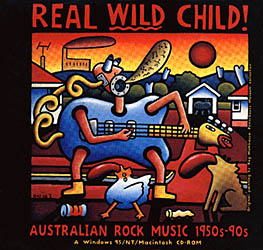REAL WILD CHILD: AUSTRALIAN ROCK MUSIC 1950s-90s (1996)

Press ReleaseReal wild child! - an irresistable experience For everyone from old rockers to cyberkids! With the same enthusiasm that the early rockers embraced the electric guitar, the Powerhouse Museum's exhibition Real wild child!: Australian rock music then and now has inspired the creation of Real wild child!: Australian rock music 1950s - 90s -- the CD-ROM. Through a surreal virtual landscape inspired by Reg Mombassa and irreverent gags and games, Real wild child! takes you on a compelling journey into the heart of Australian rock music and youth culture from the "wild child" Johnny O'Keefe in the 1950s to Savage Garden in the 1990s. Over 2000 images, over 100 movies and more than 200 excerpts from original recordings let you delve into the rich fabric of Australian rock music and the fashion, politics, social rituals, leisure and technology which helped to shape it. Real wild child! will introduce new generations to the worlds of bodgies and widgies, punks and hippies, mods and grunge. You can test your knowledge in the rock trivia quiz, play the fashion mix 'n' match game and search the index for your favourite band. By interpreting post-war Australia through its music and youth culture, the Real wild child! CD-ROM presents history in a way that is relevant to young people. It will increase awareness of the richness and diversity of Australian rock music both nationally and internationally. Real wild child! has been produced by a consortium consisting of the Powerhouse Museum, Mushroom Pictures, ABC/Triple J and Pacific Advanced Media and has been funded through the federal government's 'Australia on CD' program. Real wild child! has brought together a real wild team including TV-boy-with-attitude Richard Fidler as scriptwriter; creative direction from the very creative Mike Fronzek; and content developer Peter Cox supported by historical consultants Stephanie Lewis and Glenn A Baker, and a team of writers including Clinton Walker, James Cockington and Stuarte Coupe. |
Church Write-upThe Church The Church Canon While the band was on its third international tour (April 1986) guitarist Marty Willson-Piper quit. Tensions had arisen over Kilbey's authority within the band (he wrote nearly all the band's material), and Willson-Piper only came back into the fold under the agreement that future Church compositions would be collaborative efforts. This new-found unity immediately revealed itself on Starfish (1988), which yielded 'Under The Milky Way'. Upon release as a single in the USA it reached the Top 30. Gold Afternoon Fix (1990) featured the single 'Metropolis', whilst Priest=Aura (1992) concentrated on long, atmospheric pieces and sold over 200,000 copies in the USA in the process. Sometime Anywhere (1994) and Magician Among The Spirits (1996) picked up where Priest left off, but were not so successful commercially. For the Church's many faithful fans across the globe Steve Kilbey may well be the 'best songwriter in the world'; witness 'Almost With You', 'Tear It All Away', 'Electric Lash', 'Constant In Opal', and 'Under The Milky Way' for proof. Ian McFarlane |